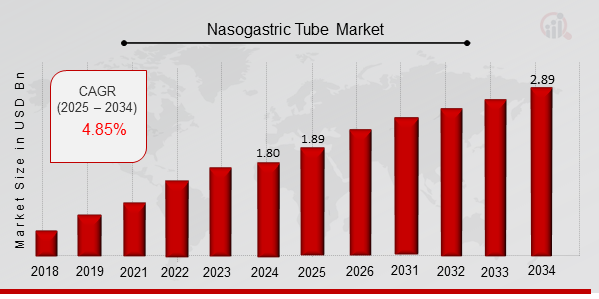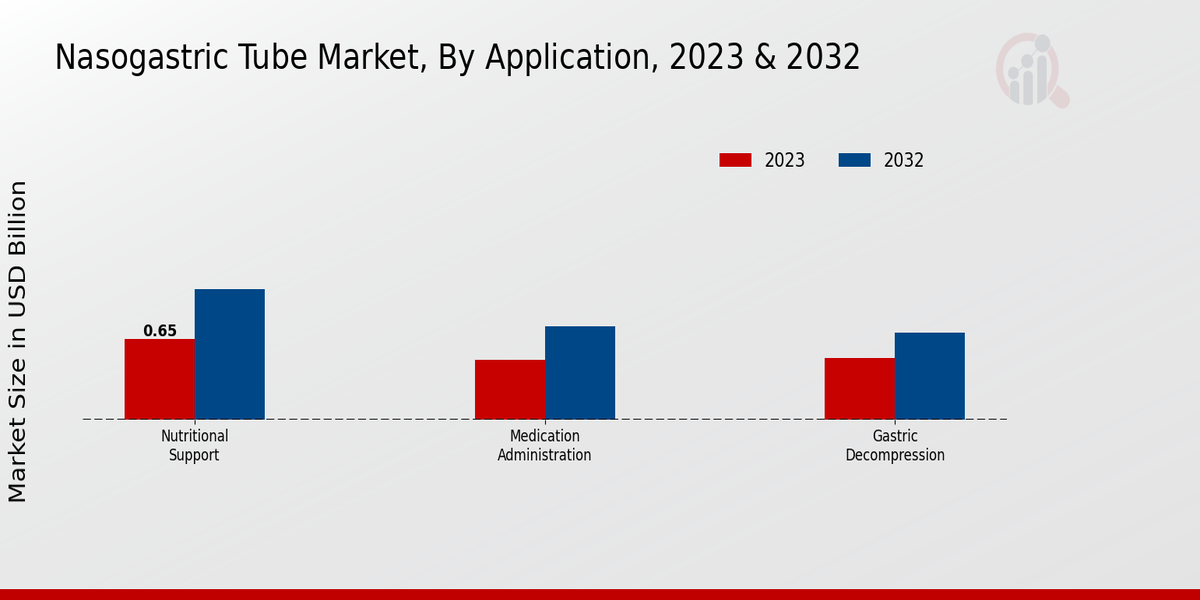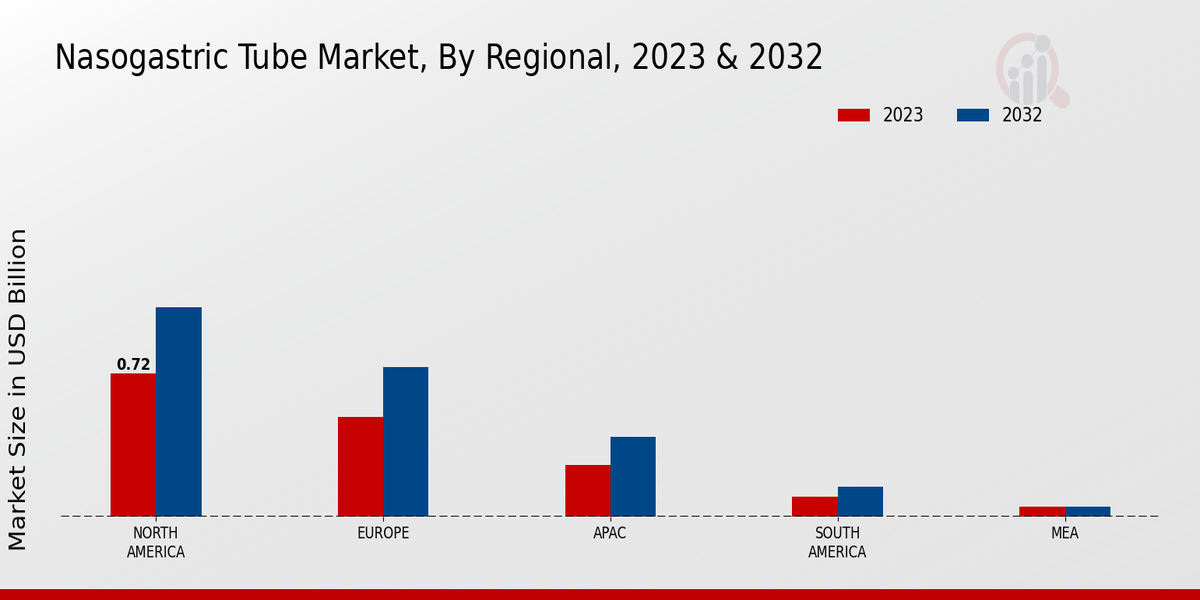Nasogastric Tube Market Overview
As per MRFR analysis, the Nasogastric Tube Market Size was estimated at 1.80 (USD Billion) in 2024. The Nasogastric Tube Market Industry is expected to grow from 1.89 (USD Billion) in 2025 to 2.89 (USD Billion) till 2034, at a CAGR (growth rate) is expected to be around 4.85% during the forecast period (2025 - 2034).
Key Nasogastric Tube Market Trends Highlighted
The Nasogastric Tube Market is experiencing a shift driven by several key factors. A significant driver includes the increasing prevalence of chronic diseases that necessitate enteral feeding. The rise in surgical procedures and advancements in healthcare infrastructure are also contributing to market growth, as healthcare providers increasingly rely on nasogastric tubes for patient care. Additionally, the aging population is leading to a higher incidence of conditions requiring enteral nutrition, further boosting demand for these medical devices. Emerging opportunities within the market present significant potential for innovation and growth.The development of more comfortable and user-friendly nasogastric tubes may capture the interest of both healthcare professionals and patients. There is also a growing focus on integrating technology, such as smart nasogastric tubes that monitor patient conditions in real-time. This could redefine patient care and management, positioning companies favorably in a competitive landscape. Regulatory support for new product approvals is another avenue for market players to explore, allowing them to launch new and improved tubes that enhance patient outcomes.
Recent trends indicate a move towards minimally invasive techniques in medical care, which aligns with the development of nasogastric tubes designed for easier insertion and reduced discomfort.Moreover, there's an increasing emphasis on patient safety, leading to innovations focused on reducing complications associated with tube placement and maintenance. These trends highlight the need for continual improvements in product design and technology to enhance efficiency and patient experience in healthcare settings. As the market evolves, staying attuned to these trends and opportunities will be crucial for stakeholders aiming to gain a competitive edge.

Source: Primary Research, Secondary Research, MRFR Database and Analyst Review
Nasogastric Tube Market Drivers
Increasing Prevalence of Chronic Diseases
The growth of the Nasogastric Tube Market Industry is significantly driven by the rising prevalence of chronic diseases that require long-term nutritional support and medication administration. Chronic conditions such as cancer, neurological disorders, and gastrointestinal diseases often lead to conditions that impede normal eating, making nasogastric tubes essential for patient care. As the world's population ages and chronic disease rates rise, the demand for medical devices to aid in the nourishment and management of these patients is surging.Additionally, as healthcare providers continuously seek efficient methods for patient management, nasogastric tubes stand out due to their ability to provide immediate and effective solutions in clinical settings. This trend not only contributes to the market growth but also highlights the importance of these medical devices in improving patient outcomes, thereby advancing the overall healthcare quality. Moreover, an increasing focus on integrating nutrition into treatment plans has further solidified the necessity of nasogastric tubes in both hospital and home care scenarios.
Technological Advancements in Medical Devices
Technological advancements in the design and functionality of nasogastric tubes are driving the Nasogastric Tube Market Industry forward. Innovations such as improved biocompatible materials, enhanced tube designs, and smart feeding systems are making nasogastric tubes safer and more effective for patient use. New features like suction capabilities, pressure monitoring, and secure placement mechanisms have made nasogastric tubes more user-friendly, thus facilitating better management of patients who require enteral feeding.As manufacturers continue to invest in research and development to create more efficient devices, the overall market for nasogastric tubes is expected to flourish, meeting the intricate needs of healthcare providers and improving patient care.
Rising Demand for Home Healthcare Services
The shift towards home healthcare services is another significant driver for the Nasogastric Tube Market Industry. With more patients preferring to receive care in the comfort of their homes, the demand for portable and easy-to-use medical devices has increased. Nasogastric tubes, being a vital component for enteral feeding, are gaining traction as they enable patients to manage their nutrition effectively at home. This transition is supported by the increasing number of chronic patients and the desire for personalized care solutions, further propelling the growth of the market.
Nasogastric Tube Market Segment Insights
Nasogastric Tube Market Application Insights
The Nasogastric Tube Market, particularly within the Application segment, encompasses critical functions such as Nutritional Support, Medication Administration, and Gastric Decompression, which are essential in both clinical and homecare settings. In 2023, the overall market is valued at 1.63 USD Billion, with the Application segment significantly contributing to this valuation.
Among these applications, Nutritional Support holds a majority stake, valued at 0.65 USD Billion in 2023, and is projected to increase to 1.05 USD Billion by 2032. This prominence can be attributed to the rising prevalence of malnutrition and disorders that impair swallowing abilities, leading to a higher demand for nutritional support solutions via nasogastric tubes.
Medication Administration, valued at 0.48 USD Billion in 2023 and expected to grow to 0.75 USD Billion by 2032, also showcases the essential role of nasogastric tubes in effectively delivering medication to patients unable to take oral medications. This application is vital in ensuring that medication regimens are adhered to without interruption, particularly in critical care scenarios, thus contributing significantly to patient recovery and comfort.
Meanwhile, Gastric Decompression, with a current valuation of 0.50 USD Billion in 2023 and a projected rise to 0.70 USD Billion by 2032, remains an important application. It effectively addresses issues such as bowel obstruction and is crucial for patient management in surgical settings, where it helps relieve pressure in the stomach. The growing incidence of gastrointestinal disorders is driving demand in this area.
The overall Nasogastric Tube Market's revenue growth is supported by these applications, reflecting a steady CAGR of 4.85 between 2024 and 2032, highlighting the increasing focus on patient safety and effective management in medical care across the board.Understanding the Nasogastric Tube Market segmentation sheds light on individual application areas, each with unique contributions and growth trajectories, underscoring opportunities for advancements and innovation within this sector. The statistics reveal a robust potential for significant societal impact through improved patient outcomes aided by nasogastric tubes in diverse clinical applications.

Source: Primary Research, Secondary Research, MRFR Database and Analyst Review
Nasogastric Tube Market Material Type Insights
The Nasogastric Tube Market is experiencing steady growth, with revenue expected to reach 1.63 billion USD in 2023 and projected to increase due to the incorporation of various material types. The material type segment includes Polyvinyl Chloride, Silicone, and Rubber, each holding significant importance due to their unique properties and applications.
Polyvinyl Chloride (PVC) is commonly favored for its cost-effectiveness and flexibility, making it a popular choice for disposable tubes. Silicone is recognized for its biocompatibility and comfort, leading to higher acceptance among patients, while Rubber is noted for its durability in medical settings.These materials play a crucial role in improving patient care and enhancing the functionality of nasogastric tubes, aligning with the trends toward more patient-centered solutions. The market growth is driven by increasing awareness of healthcare quality, technological advancements, and the rising prevalence of gastrointestinal disorders globally.
However, challenges such as stringent regulatory requirements and competition from alternative feeding methods remain prevalent in the market landscape. Overall, the diversity within this segment of the Nasogastric Tube Market guarantees sustained innovations and adaptations in response to patient needs.
Nasogastric Tube Market End User Insights
The Nasogastric Tube Market is experiencing notable growth driven by its diverse end-user category, which includes a variety of healthcare settings.
In 2023, the overall market is valued at 1.63 billion USD, reflecting a robust demand for nasogastric tubes in medical environments. Hospitals form a crucial segment, as they often require a substantial volume of these devices for patient care, enabling effective feeding and medication administration.
Home Care Settings have gained importance due to increasing patient preference for at-home treatment procedures, making them a significant contributor to the market's expansion.Long-term Care Facilities are also crucial, as they cater to residents needing continuous nutritional support, further bolstering the demand for nasogastric tubes. These segments together reflect the growing trend toward personalized and accessible healthcare solutions, providing substantial opportunities amidst the challenges of quality assurance and device management.
The Nasogastric Tube Market statistics indicate a steady rise in adoption across these sectors, showcasing their pivotal role in enhancing patient outcomes and healthcare efficiency.
Nasogastric Tube Market Tube Size Insights
The Nasogastric Tube Market is expected to reach a valuation of 1.63 USD Billion in 2023, reflecting steady demand for essential medical devices utilized in various healthcare settings. Within the Tube Size segment, the market exhibits notable diversity, prominently featuring small-bore and large-bore tubes.
Small Bore tubes are often preferred for their versatility in patients requiring less invasive feeding and secretion management, thus occupying a significant portion of the market.
Conversely, Large Bore tubes cater to specific medical conditions that necessitate rapid drainage and larger volume feeding, making them crucial in acute care scenarios.The growth in the Nasogastric Tube Market revenue is propelled by a rising global geriatric population and increasing incidences of digestive disorders, leading to higher demand for nasogastric interventions. However, challenges such as potential complications and the training required for effective tube insertion present hurdles. Opportunities lie in technological advancements and increasing awareness around enteral feeding practices, which enhance efficiency in patient care. Overall, the market segmentation highlights varying needs dictated by clinical requirements, showcasing the importance of both Tube Size categories in enhancing patient outcomes and healthcare service delivery.
Nasogastric Tube Market Regional Insights
The Nasogastric Tube Market exhibits a robust structure with significant revenue contributions from various regions. In 2023, North America dominates the market with a valuation of 0.72 USD Billion, showcasing its importance due to advanced healthcare infrastructure and a rising patient population requiring nasogastric tubes. Europe follows with a valuation of 0.5 USD Billion, reflecting a strong demand driven by rising chronic illness cases requiring nutritional support. The APAC region holds a valuation of 0.26 USD Billion, where increasing healthcare advancements and population growth present substantial opportunities for market expansion.South America and MEA, valued at 0.1 USD Billion and 0.05 USD Billion, respectively, represent the smaller segments, with MEA stable due to ongoing healthcare projects aimed at improving medical services. Overall, the Nasogastric Tube Market segmentation highlights a varied landscape where North America and Europe dominate, while APAC is poised for rapid growth, reflecting global healthcare dynamics and evolving patient care needs.

Source: Primary Research, Secondary Research, MRFR Database and Analyst Review
Nasogastric Tube Market Key Players and Competitive Insights
The Nasogastric Tube Market is characterized by a range of competitive dynamics, wherein various companies strive to establish themselves as leaders in innovation, quality, and pricing strategies. This market has witnessed significant developments driven by factors such as an increasing prevalence of chronic diseases, rising geriatric populations, and the growing demand for advanced medical devices in healthcare settings. Competition is intensified by the presence of both established players and emerging firms, each aiming to enhance their product offerings and capture market share. Key strategies include technological advancements, product differentiation, strategic partnerships, and expanding distribution networks. As companies invest in research and development to introduce new and improved nasogastric tube designs, the competitive landscape continues to evolve, catering to the diverse needs of healthcare professionals and patients alike.
Carl Zeiss AG holds a noteworthy position within the Nasogastric Tube Market, characterized by its commitment to precision and quality. The company leverages its longstanding expertise in the healthcare sector to deliver innovative solutions that meet the rigorous standards of medical professionals. With a focus on enhancing patient care, Carl Zeiss AG invests heavily in research and development, enabling it to introduce next-generation nasogastric tubes that are easier to use and improve patient comfort. The company's reputation for reliability and performance further supports its presence in the market, allowing it to foster strong relationships with healthcare providers by meeting their evolving needs. Moreover, as the company emphasizes customer education and support, it enhances its overall brand strength and significantly contributes to the advancement of nasogastric tube technology.Cook Medical is another significant player in the Nasogastric Tube Market, recognized for its comprehensive portfolio of medical devices designed for various clinical applications, including gastrointestinal health.
The company's focus on patient-centered solutions enables it to provide nasogastric tubes that emphasize ease of insertion and patient comfort, key factors that resonate well with healthcare practitioners. Cook Medical's strong commitment to innovation is evident in its continuous efforts to enhance product capabilities, including features that facilitate better handling and reduce complications associated with nasogastric tube placement. Its established distribution network and solid relationships with healthcare institutions further bolster its market presence, enabling timely access to its products for a wide range of medical settings. Consequently, Cook Medical's strategic initiatives and unwavering dedication to quality contribute to its strong positioning within the competitive landscape of the Nasogastric Tube Market.
Key Companies in the Nasogastric Tube Market Include
- Carl Zeiss AG
- Cook Medical
- Halyard Health
- Boston Scientific
- ConvaTec Group
- Medtronic
- Abbott Laboratories
- Teleflex Incorporated
- Fresenius Kabi
- Baxter International
- Braun Melsungen AG
- MediGus
- Smiths Medical
Nasogastric Tube Market Industry Developments
The Nasogastric Tube Market has recently seen significant developments with increasing advancements in medical technology and rising demand for enteral feeding solutions. Companies like Medtronic and Abbott Laboratories are investing heavily in innovative tube designs that prioritize patient comfort and reduce complications. Notably, Halyard Health and Fresenius Kabi have expanded their product lines, focusing on enhanced safety features and ease of use for healthcare professionals. Mergers and acquisitions are also shaping the market, with notable activities around Boston Scientific and Teleflex Incorporated, which are strategically aligning to strengthen their product portfolio. Market valuation is burgeoning as the increasing prevalence of chronic diseases necessitates the use of nasogastric tubes for nutrition and medication delivery. This surge in demand is propelling firms like Cook Medical and Baxter International to bolster production capabilities and expand their distribution networks. Additionally, B. Braun Melsungen AG and Smiths Medical are actively pursuing collaborations, which indicates a trend toward consolidation in the industry. The integration of digital health technologies is emerging as a critical area for future growth, particularly in monitoring and improving patient outcomes associated with nasogastric tube usage.
Nasogastric Tube Market Segmentation Insights
Nasogastric Tube Market Application Outlook
- Nutritional Support
- Medication Administration
- Gastric Decompression
Nasogastric Tube Market Material Type Outlook
Nasogastric Tube Market End User Outlook
- Hospitals
- Home Care Settings
- Long-term Care Facilities
Nasogastric Tube Market Tube Size Outlook
Nasogastric Tube Market Regional Outlook
-
North America
-
Europe
-
South America
-
Asia-Pacific
-
Middle East and Africa
| Report Attribute/Metric |
Details |
|
Market Size 2024
|
1.80 (USD Billion)
|
|
Market Size 2025
|
1.89 (USD Billion)
|
|
Market Size 2034
|
2.89 (USD Billion)
|
|
Compound Annual Growth Rate (CAGR)
|
4.85 % (2025 - 2034)
|
|
Report Coverage
|
Revenue Forecast, Competitive Landscape, Growth Factors, and Trends
|
|
Base Year
|
2024
|
|
Market Forecast Period
|
2025 - 2034
|
|
Historical Data
|
2020 - 2024
|
| Market Forecast Units |
USD Billion |
| Key Companies Profiled |
Carl Zeiss AG, Cook Medical, Halyard Health, Boston Scientific, ConvaTec Group, Medtronic, Abbott Laboratories, Teleflex Incorporated, Fresenius Kabi, Baxter International, B. Braun Melsungen AG, MediGus, Smiths Medical |
| Segments Covered |
Application, Material Type, End User, Tube Size, Regional |
| Key Market Opportunities |
Rising geriatric population demand, Increased prevalence of chronic diseases, Technological advancements in tube design, Growth in homecare settings, Expanding applications in clinical nutrition |
| Key Market Dynamics |
Increasing geriatric population, Rising prevalence of chronic diseases, Technological advancements in tube materials, Growing demand for home healthcare, Expanding healthcare infrastructure |
| Countries Covered |
North America, Europe, APAC, South America, MEA |
Frequently Asked Questions (FAQ) :
The Nasogastric Tube Market is expected to be valued at 2.89 USD Billion by 2034.
The projected CAGR for the Nasogastric Tube Market from 2025 to 2034 is 4.85%.
The Nutritional Support application segment shows the highest market value at 1.80 USD Billion in 2024.
The market size for Medication Administration is expected to reach 2.89 USD Billion by 2034.
North America is expected to hold the largest market share for the Nasogastric Tube Market.
The estimated market size of the Asia-Pacific region is projected to be 0.4 USD Billion by 2032.
The expected market values for Gastric Decompression are 0.5 USD Billion in 2023 and 0.7 USD Billion in 2032.
Key players in the Nasogastric Tube Market include Carl Zeiss AG, Cook Medical, and Halyard Health.
The overall market size in North America is valued at 0.72 USD Billion in 2023.
The market growth potential for South America is expected to reach 0.15 USD Billion by 2032.

















